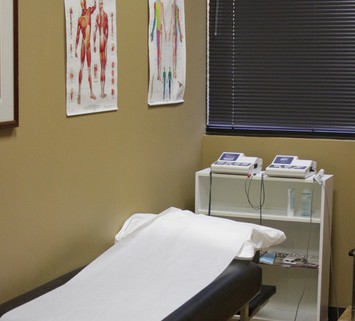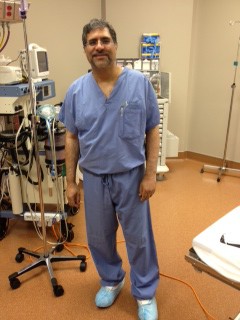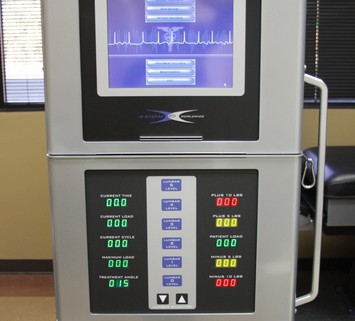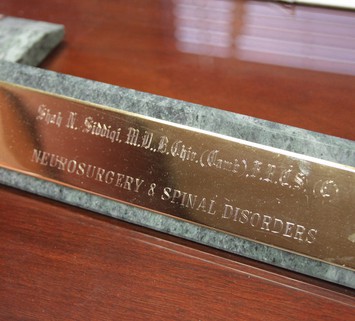One of the most archaic methods of performing spinal surgery is what's otherwise known as traditional spinal surgery, or "open back/neck" surgery. In this type of procedure, the surgeon opens up the surgical site, peeling back soft tissues, skin, and muscle so that the problem area is visible. As much as it is traditional, this is also the riskiest method, causing significantly more blood loss during the operation and exponentially increasing the patient's exposure to post-op infection.
As you might guess, this method also has the longest recovery time, during which the patient is in significant pain as all of the skin, muscles, and tissues that were affected during the surgery have to heal. Thankfully, there are other ways to treat conditions that cause back pain, including the more popular laser spine surgery, less commonly known as robotic spinal fusion surgery.
What is Laser Spinal Fusion Surgery?
It's important to know that the "laser" aspect of the surgery is only used at a specific moment during the operation. A minimally invasive spine surgery (MISS) is a procedure that minimizes risk and tissue trauma to the patient. This procedure utilizes natural pathways within the body to allow the surgeon access to the problem area through a small incision rather than opening up the entire back.
Once that pathway has been opened, a laser can be inserted to remove problematic soft tissues that cause disc herniation. Doing so decompresses the nerve causing back pain without unnecessarily exposing the patient to risks from blood loss, infection, or long recovery times.
How is it Different from Traditional Surgery? What are the Benefits?
As mentioned above, traditional surgery involves completely exposing the surgical site via a large incision that affects all surrounding tissues, increasing recovery time, pain, and infection risk. By contrast, blood loss, risk of infection, and recovery time decrease significantly during a MISS procedure.
Other Conditions that Benefit from this Procedure
Unsurprisingly, there is more than one use for lasers in minimally invasive spinal surgery beyond decompressing a herniated disc. In a practiced surgeon's hands, lasers can also be used to remove tumors attached to the spinal cord or remove bone spurs or soft tissues that have formed around other nerves. Though you should always discuss your surgical options with your doctor, laser spine surgery has also been used to treat:
- Degenerative disc diseases (in rare cases)
- Sciatica (in extreme cases)
- Deformed spine conditions
- Pinched nerves
- Spinal stenosis
- Cervical stenosis
How Long is the Recovery Time?
The average recovery time for a minimally invasive spine surgery involving robotic surgery is approximately 4 to 6 weeks. At this time, most patients can resume normal daily activities and work routines. Compared to traditional surgery, which can have recovery times of a year or longer, there's truly no comparison. Additionally, most patients can return home within a day of their surgery, offering a much more comfortable recovery experience.
With traditional spine surgery, the size of the wound you'd need to disinfect and properly dress would be too large and the tissue damage too severe for you to manage on your own, and your doctor would likely keep you in the hospital for a few weeks.
What is the Success Rate?
Research shows that minimally invasive spine surgery has a success rate of approximately 90% in relieving patient pain. Most of these patients feel relief from the chronic pain that has plagued them for years within 24 hours post-surgery. These patients will see a dramatic improvement in their quality of life, mobility, and other aspects of their health that have been negatively impacted by their back pain, such as better sleep and ability to exercise.
Is Robotic Surgery Painful?
Most surgeries will come with some level of discomfort, but robotic surgery has proven to have a dramatically less painful recovery period than traditional spine surgery. As stated above, most patients wind up being able to go home within 24 hours of their procedure and will already have begun to feel relief during that time.
That being said, it's worth noting that nothing short of extreme and persistent pain would have likely brought you to consider surgery to begin with. Compared to the chronic pain you've been struggling with, the temporary discomfort of robotic spine surgery is negligible.
Your Next Steps
Now that you know a bit more about robotic spine surgery, its uses, its benefits, and its advantages compared to more traditional surgeries, your next step is likely going to be to speak with your doctor about surgical options. Suppose your pain has become intolerable enough that you're considering surgery to correct it. In that case, it's critical to let your doctor know how the pain has impacted your livelihood. Depending on the diagnosis your doctor gives you (as there are many potential sources of chronic back pain), robotic spinal fusion surgery may well be the best option for you.
Contact your surgeon today and discuss what minimally invasive spine surgery can do to improve your quality of life. Once you're comfortable with the information you've received and feel confident that the procedure will drastically improve your post-operative life, let your surgeon know that you're ready!



